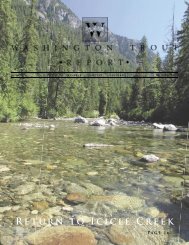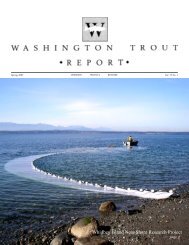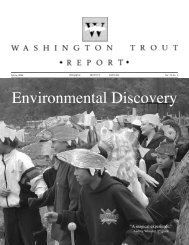Seafood Watch
Pacific Salmon - Wild Fish Conservancy
Pacific Salmon - Wild Fish Conservancy
- No tags were found...
You also want an ePaper? Increase the reach of your titles
YUMPU automatically turns print PDFs into web optimized ePapers that Google loves.
<strong>Seafood</strong> <strong>Watch</strong>® Wild Pacific Salmon Report October 8, 2010<br />
Table 2.1. Summary abundance of targeted wild West Coast salmon species, by state.<br />
State Species Abundance 14 Trends (Escapement or<br />
Landings<br />
Variable. Most Oregon stocks<br />
Oregon Chinook<br />
appear to be meeting escapement<br />
Highly depleted from historic<br />
goals, but Oregon fishery harvests<br />
levels.<br />
declining Sacramento River fall<br />
runs.<br />
Chinook<br />
Highly depleted from historic<br />
Variable.<br />
Washington<br />
Alaska<br />
Chum<br />
Pink<br />
Sockeye<br />
Chinook<br />
Chum<br />
Coho<br />
Pink<br />
Sockeye<br />
levels.<br />
Variable: Puget Sound stocks at<br />
record abundance; Coastal stocks<br />
unknown.<br />
Variable: 6 stocks healthy, 6 stocks<br />
depleted. Targeted stocks healthy.<br />
Variable: 2 stocks healthy, 4 stocks<br />
depleted. Targeted stocks healthy.<br />
Excellent: Escapement within<br />
management targets.<br />
Escapement at or above<br />
management targets.<br />
Escapement strong for all<br />
monitored rivers.<br />
Historic highs due to<br />
augmentation; wild escapement<br />
meeting management targets.<br />
Excellent.<br />
Short-term increases in escapement<br />
and run-size in Puget Sound.<br />
Short-term increases in escapement.<br />
Variable: Targeted runs have<br />
increasing short-term trends.<br />
Landings steady. Average<br />
escapement.<br />
Long-term increases in landings.<br />
Average escapement.<br />
Long-term increases in escapement<br />
and landings.<br />
Long-term increases in escapement<br />
and landings due largely to hatchery<br />
supplementation.<br />
Long-term increases in escapement,<br />
landings since mid-70s.<br />
There is an ongoing debate in the management and legal community as to whether artificially<br />
propagated salmon ought to be included when considering the health of an ESU. While there are<br />
valid economic and sometimes environmental reasons to encourage hatcheries, this review<br />
attempts to focus on the health and abundance of only wild fish for the following reasons.<br />
First, when hatchery fish are included in stock assessments, many ESUs that are otherwise<br />
failing, such as several in the Columbia River Basin, appear to be in reasonable health. As such,<br />
high levels of hatchery releases can mask declines in wild populations. Because salmon fisheries<br />
are generally mixed-stock fisheries, targeting hatchery fish can increase the harvest rates of wild<br />
fish. Myers, Levin et al. (2004) comment: “Including hatchery fish in an ESU confounds risk of<br />
extinction in the wild with ease of captive propagation and ignores important biological<br />
differences between wild and hatchery fish.”<br />
Second, by competing with wild salmon for food and other resources, empirical evidence<br />
indicates that hatchery releases reduce marine survival rates of wild salmon, particularly in years<br />
of poor ocean conditions. As a consequence, a high abundance of hatchery fish that might<br />
otherwise indicate a healthy ESU has the potential to negatively affect survival rates and the<br />
14 See subsequent discussion for citations.<br />
39






